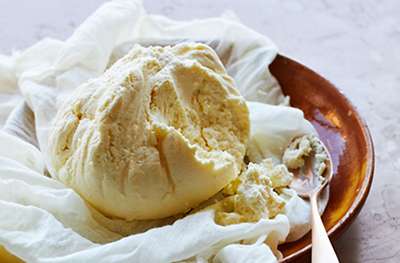
- Serves4
- CourseAccompaniment
- Prepare1 hr
- Cook5 mins
- Total time1 hr 5 mins
- Pluscooling
Ingredients
- 1 L 1.136L bottle (I used Waitrose Duchy Organic Whole Milk)
- 150ml Essential Double Cream
- 1½ lemons, juice (55ml)
- 1 tsp sea salt flakes
Method
Put the milk and cream in a large saucepan. Warm over a medium heat to 90ºC. Use a thermometer, if possible, but if you don’t have one, it’s likely to be around 90ºC when see the mixture start to foam on the surface and around the edges, as it nears boiling point. Be careful not to let it boil.
Remove from the heat, then add the lemon juice and sea salt flakes, gently stirring once to combine. The lemon will cause the milk and cream to coagulate. Leave the mixture to rest at room temperature for 10 minutes.
Place a fine mesh sieve over a large bowl. Fold a large piece of clean muslin or cheesecloth so it is double thickness, then lay it inside the sieve. Carefully pour the milk mixture into the lined sieve and leave it to drain for 1 hour. The longer the ricotta sits, the thicker it will be. Check regularly and pour the drained whey into another container, so the bottom of the sieve is not sitting in liquid. Keep the whey to use in other recipes (see my tip).
Gently lift the cheesecloth out of the strainer, gather the fabric around the cheese and lightly squeeze out the excess liquid. Transfer the ricotta to a bowl if serving immediately, or into a sealable storage container to be stored in the fridge (for up to 3 days) or freezer (for up to 1 month). Defrosted ricotta may have a slightly grainy texture, so is best used in recipes where it will be cooked, such as a lasagne.
Cook’s tip
A quick search online and you’ll find hundreds of uses for leftover whey from making cheese – everything from adding some to the water to soak grains, to marinating meat, feeding your dog and more. (Note that what you’ll have after making ricotta is ‘acid whey’ not ‘sweet whey’, which is the byproduct of strained yogurt making.) It’s full of goodness (vitamins, minerals and protein), so don’t throw it away!
Nutritional
Typical values per serving when made using specific products in recipe
Energy | 995kJ/ 240kcals |
|---|---|
Fat | 19g |
Saturated Fat | 12g |
Carbohydrates | 9.3g |
Sugars | 9.3g |
Fibre | 0g |
Protein | 6.7g |
Salt | 1g |


